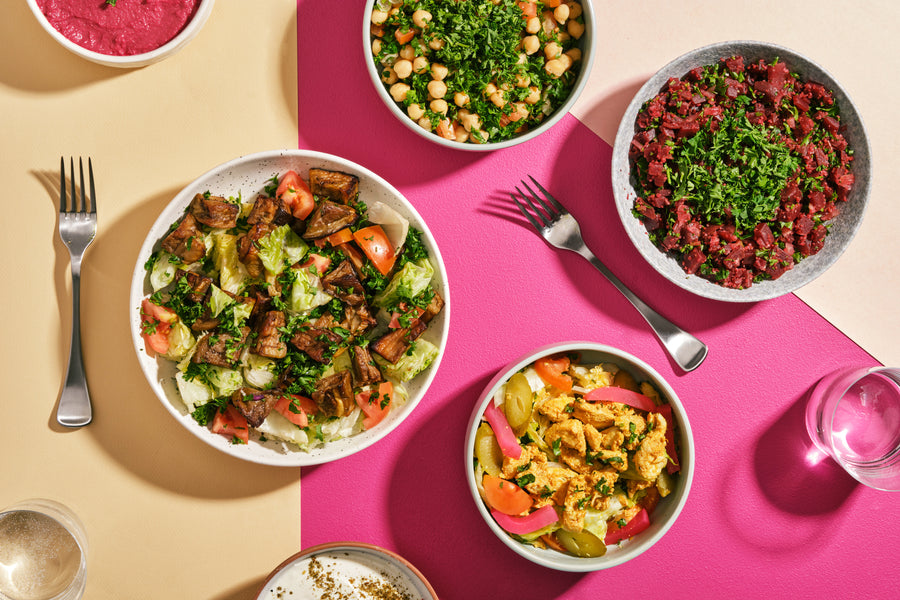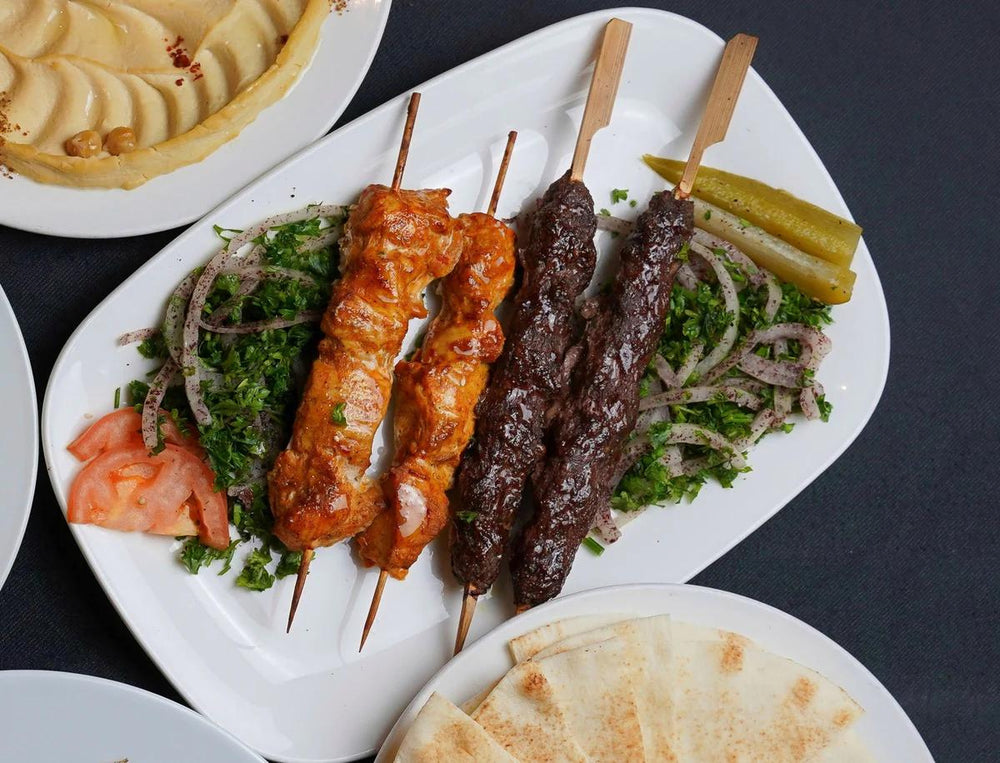A Deep Dive Into Syrian Cuisine: Recognizing Its Cultural Importance and Halal Elements
Syrian food personifies an abundant tapestry of cultural impacts and historical narratives. Each meal narrates of area and practice, highlighting the relevance of shared meals. The adherence to halal methods not only reflects faiths however likewise shapes the identification of Syrian cooking. As global events challenge these culinary traditions, the strength of this cuisine continues to be a focal point of cultural preservation. What lies behind the tastes that specify this withstanding heritage?
The Historic Roots of Syrian Food
Although Syrian cuisine has evolved over centuries, its historic origins are deeply intertwined with the area's varied cultural influences. Situated at the crossroads of different human beings, Syria has taken in culinary methods from the Phoenicians, Greeks, Romans, and Ottomans, amongst others. This abundant tapestry of history has contributed to a cuisine characterized by a mix of flavors, flavors, and cooking strategies. The productive lands of the region have actually likewise played a vital function, supplying a wealth of grains, fruits, and vegetables that develop the foundation of many recipes. The intro of new ingredients through profession and conquest even more improved the culinary landscape, enabling the development of unique local specializeds. In addition, the impact of surrounding countries has caused a vibrant exchange of culinary ideas, solidifying Syria's setting as a considerable gamer in the more comprehensive context of Middle Eastern gastronomy.

Conventional Syrian Meals and Their Cultural Significance
Standard Syrian meals are not only culinary staples but also bring deep social significance, showing the nation's rich heritage. Renowned meals, commonly prepared throughout festive occasions, function as a way of unifying areas and households. These meals symbolize the flavors of Syria while reinforcing social bonds through shared traditions and parties.
Iconic Syrian Staples
When checking out the abundant tapestry of Syrian cuisine, one uncovers a range of iconic meals that not just tantalize the palate but additionally symbolize the nation's cultural heritage. Amongst these staples, Kabsa sticks out as a fragrant rice meal, typically seasoned with seasonings like saffron and cardamom, signifying friendliness. Fattoush, a vivid salad made with combined greens and crunchy bread, mirrors the value of fresh ingredients in Syrian food preparation. Muhammara, a spicy dip made from peppers and walnuts, showcases the abundant tastes characteristic of the region. Additionally, Kibbeh, a dish made from bulgur and minced meat, is typically pertained to as a national prize, standing for public celebrations. Each recipe tells a story, attaching individuals to their practices and roots.
Cheery Dish Customs
Syrian cheery dish customs are rich with meaning and relevance, as families gather to celebrate important events via the sharing of cherished dishes. Meals typically showcase a range of standard foods, with dishes like mansaf, kibbeh, and tabbouleh taking spotlight. Each meal lugs cultural history; as an example, kibbeh, made from bulgur and minced meat, stands for friendliness and wealth. Throughout Ramadan and Eid, households prepare unique sugary foods such as maamoul, signifying pleasure and unity. These gatherings foster community bonds, as sharing a dish symbolizes love and togetherness. The preparation and satisfaction of these meals reflect Syria's varied cooking heritage, linking household customs and local impacts, consequently improving the joyful experience and maintaining social identity.
The Function of Family and Area in Syrian Food Culture
Food works as a vital thread that weaves with each other family and community in Syrian culture. Meals are frequently communal experiences, where households gather around a table to share traditional dishes that reflect their heritage. The preparation of food is a common activity, with generations working side by side, passing down recipes and cooking techniques. This technique enhances familial bonds and promotes a feeling of belonging within the community.Special events and religious celebrations even more highlight the significance of food in Syrian society. Throughout these events, families prepare elaborate meals that offer not just to nurture yet additionally to reveal love and friendliness. The act of sharing food represents view it unity and assistance among friends and next-door neighbors, reinforcing social ties. Via these shared cooking experiences, Syrians grow Check Out Your URL a solid identity rooted in their abundant cultural history, highlighting how food transcends mere food to come to be a crucial part of their social textile.
Halal Practices in Syrian Cooking
In the context of common dishes and family celebrations, halal techniques play a substantial function in Syrian cooking. These practices stem from Islamic nutritional laws, ensuring that food is prepared and consumed in a fashion that straightens with spiritual beliefs. For numerous Syrian family members, adherence to halal principles affects numerous elements of dish prep work, from sourcing components to cooking methods.Animals utilized for meat must be butchered according to certain guidelines, stressing gentle therapy and invoking the name of Allah. Additionally, cross-contamination with non-halal items is meticulously stayed clear of in both home kitchen areas and industrial establishments.This dedication to halal not just reflects spiritual commitment however likewise fosters a feeling of community, as family members usually collaborated to share meals that honor these practices - Brunch Kitsilano Vancouver BC. Halal methods are deeply woven into the material of Syrian cooking culture, forming both day-to-day life and festive occasions.
Ingredients That Specify Syrian Tastes

The essence of Syrian food is formed by a harmonious mix of key spices and herbs that improve its distinct tastes. Conventional food preparation strategies additionally boost these active ingredients, showcasing the rich culinary heritage of the region. A summary of crucial components discloses the foundational function they play in developing genuine Syrian recipes.
Secret Seasonings and Herbs
A dynamic tapestry of tastes identifies Syrian food, with vital seasonings and herbs playing an essential role in defining its essence. Famous amongst these are sumac, cumin, and coriander, which provide deepness and heat to numerous meals. Cumin, with its nutty aroma, typically boosts stews and smoked meats, while coriander adds a citrusy note to dips and salads. Sumac, understood for its appetizing flavor, brightens meals and is often sprinkled over fattoush or kebabs. Furthermore, cinnamon and allspice offer a refined sweet taste, commonly located in both pleasant and savory preparations. Fresh herbs like mint, parsley, and dill are likewise important, offering a ruptured of freshness and balancing the rich, complex tastes that make Syrian food one-of-a-kind.
Standard Cooking Techniques
Cooking strategies in Syrian food reflect an ingrained tradition that boosts the tastes of its active ingredients. Methods such as slow-cooking and braising are frequently used, allowing herbs and seasonings to fuse wonderfully with meats and vegetables. Cooking, especially over charcoal, presents a smoky splendor to recipes like kebabs, while steaming is typically made use of for rice, protecting its appearance and taste. Additionally, sautéing is favored for preparing aromatic bases, frequently beginning with onions and garlic to develop depth. Fermentation contributes in producing special tastes, noticeable in meals like pickled vegetables. These strategies not just highlight the top quality of active ingredients but additionally symbolize the communal spirit of food preparation, bringing families together around shared dishes soaked in practice.
Necessary Components Overview
While checking out Syrian cuisine, one rapidly uncovers that necessary ingredients play a pivotal function in specifying its special tastes. Olive oil, a staple, gives splendor and deepness, commonly offering as a base for many dishes. Fresh herbs, such as mint, cilantro, and parsley, contribute dynamic blog aromas and preferences, improving the overall experience (Brunch Kitsilano Vancouver BC). Spices like cumin, coriander, and cinnamon are regularly used, including heat and complexity to meals. Additionally, Syrian cuisine heavily integrates grains, particularly bulgur and rice, which work as essential parts in numerous dishes. Pulses, especially chickpeas and lentils, supply both nourishment and texture. With each other, these ingredients produce the harmonious balance that characterizes Syrian recipes, reflecting the country's abundant cooking heritage and social importance
The Effect of Battle on Syrian Culinary Customs
The battle in Syria has wrought devastation across the country, its influence on cooking traditions reveals an intricate interaction of durability and adjustment. As areas dealt with displacement, standard dishes were changed because of the scarcity of sources and components. Households typically count on locally offered produce, integrating brand-new flavors and methods right into their meals, which led to the introduction of special interpretations of timeless dishes.Moreover, the battle promoted a spirit of uniformity among displaced cooks and home cooks, who shared their cooking expertise via social media and area kitchen areas. This sharing of dishes not only maintained social heritage but also created a feeling of belonging among those affected by the problem. Despite the difficulties, the enthusiasm for food stays a unifying force, allowing individuals to preserve their identity and link with their origins, even in exile. Syrian cuisine proceeds to progress amid difficulty, mirroring both an abundant background and contemporary durability.
Frequently Asked Questions
What Are Common Cooking Techniques Used in Syrian Cuisine?
Common food preparation strategies in Syrian food consist of grilling, baking, sautéing, and stewing. These methods improve flavors and textures, allowing for the development of varied meals that mirror the area's rich cooking heritage and traditions.
Just How Has Globalization Influenced Syrian Food?

Are There Vegetarian Options in Conventional Syrian Meals?
Vegan choices prevail in typical Syrian recipes, including components like lentils, veggies, and chickpeas. Popular meals such as Mujadara and Falafel highlight this variety, suiting numerous nutritional choices while protecting the abundant flavors of the food.
What Beverages Set Well With Syrian Meals?
Beverages that match well with Syrian meals consist of mint tea, pomegranate juice, and ayran - Brunch Kitsilano Vancouver BC. These beverages enhance the tastes of standard recipes, boosting the eating experience while offering invigorating contrasts to the rich, savory tastes
Exactly How Do Syrians Celebrate Food During Holidays or Festivals?
Syrians celebrate food during vacations and festivals with elaborate banquets, frequently including typical recipes. Family gatherings highlight sharing dishes, symbolizing unity and social heritage, while special treats and sugary foods highlight the festive spirit and common pleasure. Traditional Syrian meals are not just cooking staples but likewise carry deep cultural relevance, reflecting the nation's abundant heritage. When checking out the rich tapestry of Syrian cuisine, one discovers a range of famous dishes that not just entice the taste but additionally embody the nation's cultural heritage. Syrian joyful meal customs are rich with importance and value, as family members gather to celebrate important events through the sharing of precious recipes. Food preparation strategies in Syrian food reflect a deep-rooted practice that improves the tastes of its active ingredients. Vegan choices are widespread in traditional Syrian meals, featuring components like chickpeas, vegetables, and lentils.